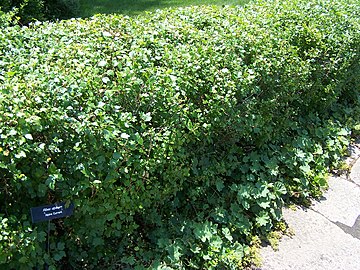Ribes alpinum: Difference between revisions
No edit summary |
→top: added edibility Tags: Mobile edit Mobile app edit Android app edit |
||
| (8 intermediate revisions by 8 users not shown) | |||
| Line 1: | Line 1: | ||
{{Short description|Species of shrub}} |
|||
{{Italic title}} |
{{Italic title}} |
||
{{Speciesbox |
{{Speciesbox |
||
| Line 20: | Line 21: | ||
}}}} |
}}}} |
||
'''''Ribes alpinum''''', known as '''mountain currant'''<ref name=BSBI07>{{ |
'''''Ribes alpinum''''', known as '''mountain currant'''<ref name=BSBI07>{{BSBI 2007 |accessdate=2014-10-17 }}</ref> or '''alpine currant''',<ref>{{PLANTS|id=RIAL2|taxon=Ribes alpinum|accessdate=22 October 2015}}</ref> is a small [[deciduous]], [[dioecious]]<ref name=Agroatlas/> [[shrub]] native to central and northern [[Europe]] from [[Finland]] and [[Norway]] south to the [[Alps]] and [[Pyrenees]] and [[Caucasus]], [[Georgia (country)|Georgia]]; in the south of its range, it is confined to high altitudes. It is scarce in western Europe, in [[Great Britain|Britain]] being confined to a small number of sites in northern [[England]] and [[Wales]].<ref name=rbge>{{ cite web |url=http://rbg-web2.rbge.org.uk/cgi-bin/nph-readbtree.pl/feout?FAMILY_XREF=&GENUS_XREF=Ribes&SPECIES_XREF=alpinum&TAXON_NAME_XREF=&RANK= |title='''Flora Europaea: ''Ribes alpinum'' query results''' |publisher=[[Royal Botanic Garden Edinburgh]] |accessdate=August 20, 2009}}</ref> |
||
'' |
''R. alpinum'' grows to {{Convert|2|m|ft|abbr=off|frac=2}} tall and {{Convert|1.5|m|ft|abbr=on|frac=2}} broad, with an upright and dense shape. The [[Bark (botany)|bark]] is initially smooth and light grey, later it becomes brownish grey and eventually starts to flake off. The [[bud]]s are scattered, compressed and light green to white. The [[leaves]] are [[palmate]]. The upper side of the leaves are dark green with scattered hair, while the bottom is light green. The male and female [[flower]]s are on distinct specimens. Both kinds of flowers are organized in clusters in the corners of the leaves, where the male's are the longest. The individual flowers are small and greenish-yellow. The edible [[fruit]] is red, clear and resembles a [[redcurrant]], but has an insipid taste. The seeds germinate readily.<ref name=Agroatlas>[http://www.agroatlas.ru/en/content/related/Ribes_alpinum/ Agroatlas, Agricultural Ecological Atlas of Russia and Neighboring Countries]</ref><ref>[http://wilde-planten.nl/alpenbes.htm Wilde Planten in Nederlane en België, Ribes alpinum] in Dutch with photos and global distribution map</ref> |
||
{{gallery|mode=packed |
|||
|Ribes alpinum MN 2007.JPG|An alpine currant hedge at the [[Minnesota Landscape Arboretum]] |
|||
}} |
|||
==References== |
==References== |
||
| Line 34: | Line 37: | ||
[[Category:Flora of Europe]] |
[[Category:Flora of Europe]] |
||
[[Category:Plants described in 1753]] |
[[Category:Plants described in 1753]] |
||
[[Category:Taxa named by Carl Linnaeus]] |
|||
[[Category:Dioecious plants]] |
|||
{{Saxifragales-stub}} |
{{Saxifragales-stub}} |
||
Latest revision as of 19:24, 21 July 2024
| Alpine currant | |
|---|---|

| |
| A twig of alpine currants | |
| Scientific classification | |
| Kingdom: | Plantae |
| Clade: | Tracheophytes |
| Clade: | Angiosperms |
| Clade: | Eudicots |
| Order: | Saxifragales |
| Family: | Grossulariaceae |
| Genus: | Ribes |
| Species: | R. alpinum
|
| Binomial name | |
| Ribes alpinum | |
| Synonyms[1] | |
|
List
| |
Ribes alpinum, known as mountain currant[2] or alpine currant,[3] is a small deciduous, dioecious[4] shrub native to central and northern Europe from Finland and Norway south to the Alps and Pyrenees and Caucasus, Georgia; in the south of its range, it is confined to high altitudes. It is scarce in western Europe, in Britain being confined to a small number of sites in northern England and Wales.[5]
R. alpinum grows to 2 metres (6+1⁄2 feet) tall and 1.5 m (5 ft) broad, with an upright and dense shape. The bark is initially smooth and light grey, later it becomes brownish grey and eventually starts to flake off. The buds are scattered, compressed and light green to white. The leaves are palmate. The upper side of the leaves are dark green with scattered hair, while the bottom is light green. The male and female flowers are on distinct specimens. Both kinds of flowers are organized in clusters in the corners of the leaves, where the male's are the longest. The individual flowers are small and greenish-yellow. The edible fruit is red, clear and resembles a redcurrant, but has an insipid taste. The seeds germinate readily.[4][6]
-
An alpine currant hedge at the Minnesota Landscape Arboretum
References
[edit]- ^ The Plant List, Ribes alpinum L.
- ^ BSBI List 2007 (xls). Botanical Society of Britain and Ireland. Archived from the original (xls) on 2015-06-26. Retrieved 2014-10-17.
- ^ NRCS. "Ribes alpinum". PLANTS Database. United States Department of Agriculture (USDA). Retrieved 22 October 2015.
- ^ a b Agroatlas, Agricultural Ecological Atlas of Russia and Neighboring Countries
- ^ "Flora Europaea: Ribes alpinum query results". Royal Botanic Garden Edinburgh. Retrieved August 20, 2009.
- ^ Wilde Planten in Nederlane en België, Ribes alpinum in Dutch with photos and global distribution map

